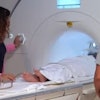Millennium Technology
Millennium Technology arrived at RSNA 1999 heralding Canada's first home-grown MRI scanner, Virgo, which received FDA 510(k) clearance in October 1998. An open C-gap unit with permanent magnet technology, Virgo combines low purchase, operating, and siting costs with Java-based software that runs on the Windows NT operating system.
For this year's RSNA conference, Virgo's operating software has been greatly enhanced in both speed and resolution, according to Millennium founder and president Illich Cheng. New coils have also been developed specifically for breast and prostate imaging.
While the company has already sold several scanners in Canada, Vancouver, BC-based Millennium is still looking for a U.S. marketing partner, Cheng said.
ONI
ONI is a new entrant in the hotly competitive MR market. Founded in June 1997, ONI is a privately held company headquartered in North Andover, MA. The company is making its RSNA debut with the recently introduced OrthOne, a 1-tesla scanner designed for extremity applications.
According to CEO Bob Kwolyk, the system's high field strength and gradient system enhances clinical flexibility and productivity with a wide range of pulse-sequence options at fast acquisition speeds. At high-volume sites with heavy patient backlogs, OrthOne can supplement a facility's whole-body unit as a low-cost second system.
OrthOne received 510(k) clearance from the FDA in August, and ONI is installing the product in five clinical locations in the first quarter of 2001.
Siemens Medical Systems
Siemens highlights will range from Magnetom Jazz, an extremity imaging system, to Allegra, a 3-tesla scanner designed for neuro-oriented research. Siemens will also showcase recent advancements made in its development of a 1-tesla high-field open scanner, first displayed at last year's meeting as a work in progress.
Toshiba America Medical Systems
Excelart XG is a new work-in-progress version of Toshiba’s 1.5-tesla Excelart platform that the Tustin, CA, company will be highlighting this year. Excelart XG features Pianissimo Plus, a new version of Toshiba’s Pianissimo noise-reduction technology, according to John Zimmer, vice president of marketing at the company.
The company developed Pianissimo to address noise problems created by the increasing use of more powerful gradients during MRI scanning. The first generation of the technique was introduced at the 1999 meeting and reduces noise produced by MRI gradients by 70%, Zimmer said.
Pianissimo Plus improves on that performance, lowering overall noise levels by 90% compared with a system that does not use the technique. Excelart XG users can employ Pianissimo Plus in 80% of pulse sequences, Zimmer said.
In other Excelart XG additions, Toshiba will display new cardiac and proton spectroscopy packages for the system. The XG upgrade also features stronger gradients.
For the company’s open-configuration Opart scanner, Toshiba will highlight the new Paragon configuration, which adds multichannel array electronics and a series of coils to support advanced imaging applications. Opart Paragon users will be able to conduct diffusion-weighted and perfusion-weighted imaging, as well as peripheral gating for peripheral angiography studies.
By Brian Casey, Eric Barnes, and Jonathan S. Batchelor
AuntMinnie.com staff writers
November 16, 2000
Go to page:
Fonar through Marconi
Millennium through Toshiba
Copyright © 2000 AuntMinnie.com
















